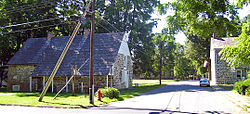Historic Huguenot Street | |
 The Bevier-Elting House, left, and Dubois Fort, location of the Visitor Center at Historic Huguenot Street | |
| Location | New Paltz, New York |
|---|---|
| Nearest city | Poughkeepsie |
| Coordinates | 41°45′00″N 74°05′21″W / 41.75000°N 74.08917°W |
| Area | 10 acres (4.0 ha) |
| Built | Founded 1678. Houses date to ca1705. |
| Architectural style | Dutch-style colonial; Georgian. |
| Visitation | 16,500 (2007) |
| NRHP reference No. | 66000578 |
| Significant dates | |
| Added to NRHP | October 15, 1966[1] |
| Designated NHLD | October 9, 1960[2] |
Historic Huguenot Street is located in New Paltz, New York, approximately 90 miles (140 km) north of New York City. The seven stone houses and several accompanying structures in the 10-acre National Landmark Historic District were likely built in the early 18th century by Huguenot settlers fleeing discrimination and religious persecution in France and what's now southern Belgium. After negotiating with the Esopus Indians, this small group of Huguenots settled on a flat rise on the banks of the Wallkill River in 1678. The settlers named the site in honor of Die Pfalz, the region of present-day Germany that had provided them temporary refuge before they came to America.[3] Archaeological finds indicate that the immediate area settled by the Huguenots was occupied by Native Americans prior to European contact. The site is one of the oldest continuously inhabited settlements in the United States.
The house museums of Historic Huguenot Street are in their original village setting. The street has been included in the National Register of Historic Places since it was created in 1966, and was designated a National Historic Landmark in 1960.[2][4]
In addition to the houses, the 10-acre (4.0 ha) site features a burying ground dating to the early 18th century, a reconstructed 1717 stone church, a visitor center, a library and archives, and spaces for other programming.
The site is owned and operated by Historic Huguenot Street, which was founded in 1894. In 1899, Historic Huguenot Street purchased the Jean Hasbrouck house as the first house museum on the street. In the 1950s and '60s, the organization and related family associations purchased most of the remaining stone houses in the district and subsequently opened them as museums. These acquisitions were funded in large part by descendants of the original Huguenot founders. Their family associations play a key role in supporting the institution today.[citation needed]
In the 1980s, the organization began offering related educational and informative programming to the public.
- ^ "National Register Information System". National Register of Historic Places. National Park Service. January 23, 2007.
- ^ a b "Historic Huguenot Street". National Historic Landmark summary listing. National Park Service. September 15, 2007. Archived from the original on June 5, 2011.
- ^ Eric J. Roth, "History of New Paltz", New York History, 1989, Issue 4, at History Cooperative
- ^ Charles H. Ashton; Constance M. Greiff; Richard W. Hunter (October 15, 1984). "National Register of Historic Places Inventory-Nomination: Huguenot Street Historic District National Historic Landmark" (pdf). National Park Service.
{{cite journal}}: Cite journal requires|journal=(help) and Accompanying 25 photos, from 1984 and 1967. (8.51 MB)

